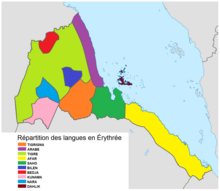Languages of Eritrea
| Languages of Eritrea Main | Tigrinya, Tigre, Kunama, Bilen, Nara, Saho, Afar, Beja[1][2] | |
|---|---|---|
| Foreign | English, Arabic | |
| Signed | Eritrean Sign Language, older sign languages | |
| Keyboard layout | ||
| Part of a series on the |
| Culture of Eritrea |
|---|
 |
| History |
|
People |
| Languages |
| Cuisine |
| Religion |
|
Art |
|
Literature |
| Music |
| Sport |
The main languages spoken in Eritrea are Tigrinya, Tigre, Kunama, Bilen, Nara, Saho, Afar, and Beja. The country's working languages are Tigrinya, Arabic, English.
Tigrinya is the most widely spoken language in the country and had 2,540,000 native speakers out of the total population of 5,254,000 in 2006.[3] The remaining residents primarily speak other languages from the Afroasiatic family, Nilo-Saharan languages or Indo-European languages.
Ethno-linguistic demographics
According to linguists, the first
Eritrea's population now comprises nine
Estimates of numbers of speakers given below are from
Afro-Asiatic languages

The languages spoken in Eritrea are
- Tigrinya people. As of 2006, there were around 2.54 million speakers.
- Tigre, spoken by the Tigre people. As of 2006, there were around 1.05 million speakers.
- Dahlik, spoken in the Dahlak Archipelago. Variously regarded as either a divergent dialect of Tigre or a separate language, it was recently assigned its own ISO 639-3code. As of 2012, there were around 2,500 speakers.
Other Afro-Asiatic languages belonging to the family's Cushitic branch are also spoken in the country.[7] They are spoken by around 10% of residents and include:
- Beja (Bedawiyet), spoken by the Hedareb. It is sometimes classified as an independent branch of the Afro-Asiatic family. As of 2006, there were 158,000 speakers in Eritrea.
- Saho, spoken by the Saho people. It is sometimes grouped with Afar as Saho-Afar. As of 2006, there were around 191,000 speakers in Eritrea.
- Afar, spoken by the Afar people, predominantly in Ethiopia and Djibouti. As of 2006, there were fewer than 100,000 speakers in Eritrea.
- Blin or Bilen, spoken by the Bilen peoplein the Anseba region and Keren town area. As of 2006, there were around 91,000 speakers.
Nilo-Saharan languages
In addition, languages belonging to the
Foreign languages
Arabic is mostly found in the form of Modern Standard Arabic as an educational language taught in primary and secondary schools, but there are native speakers of dialectal variants of Arabic, as follows:
- Sudanese Arabic; spoken by approximately 90% of Arabic speakers of Eritrea, also spoken by Sudanese Arabs. As of 2006 there were around 100,000 speakers in Eritrea.[8]
- Hadhrami Arabic with about 100,000 speakers as of 2006.[9]
- Hijazi Arabic, spoken by the Rashaida. As of 2006, there were around 24,000 speakers.
- Ta'izzi-Adeni Arabic with about 18,000 speakers as of 2006.[9]
Italian was introduced in the 19th century by the colonial authorities in Italian Eritrea but is now used in commerce at times. It serves as the mother tongue of a few Italian Eritreans, but is still understood and spoken as a "pidgin" [10] by many old Eritreans mainly in Asmara and Massawa.
English was introduced in the 1940s under the British military administration of Italian Eritrea. It is now used as the de facto working language.[citation needed]
Official status
The 1997
Writing and literacy
According to the Ministry of Information of Eritrea, an estimated 80% of the country's population is literate.[12]
In terms of
Notes
- ^ doi:10.1080/01434639908666385. Archived from the original(PDF) on 2015-09-23. Retrieved 2012-04-04.
- ^ "Africa :: Eritrea — The World Factbook - Central Intelligence Agency". www.cia.gov. Archived from the original on June 12, 2007.
- ^ "Eritrea". Ethnologue. Retrieved 9 November 2017.
- ^ Zarins, Juris (1990), "Early Pastoral Nomadism and the Settlement of Lower Mesopotamia", (Bulletin of the American Schools of Oriental Research)
- ISBN 0759104662. Retrieved 8 September 2014.
- ^ ISBN 0313306109.
The majority of the Eritreans speak Semitic or Cushitic languages of the Afro-Asiatic language group. The Kunama, Baria, and other smaller groups in the north and northwest speak Nilotic languages.
- ^ "Languages of Eritrea". Retrieved 27 September 2023.
- ^ a b "Languages of Eritrea". Retrieved 27 September 2023.
- ^ Eritrean Pidgin Italian was developed during colonial times
- ^ "People and Languages » Embassy of The State of Eritrea". www.eritrean-embassy.se. Archived from the original on 2012-09-28.
- ^ Ministry of Information of Eritrea. "Adult Education Program gaining momentum: Ministry". Shabait. Retrieved 9 October 2013.
- ^ Rodolfo Fattovich, "Akkälä Guzay" in Uhlig, Siegbert, ed. Encyclopaedia Aethiopica: A-C. Wiesbaden: Otto Harrassowitz KG, 2003, p. 169.
- ^ "Afar (ʿAfár af)". Omniglot. Retrieved 23 August 2013.
References
- Woldemikael, Tekle M (April 2003). "Language, Education, and Public Policy in Eritrea". African Studies Review. 46 (1): 117–136. S2CID 143172927.


